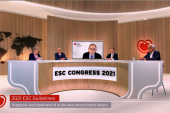Empagliflozin Plus an MRA Is Safe in HFpEF, May Help With Hyperkalemia
The findings should give clinicians confidence that both drugs can be started in this patient group, if clinically warranted, one expert says.

A new analysis of the EMPEROR-Preserved trial sheds light on the efficacy of the sodium-glucose cotransporter 2 (SGLT2) inhibitor empagliflozin (Jardiance; Boehringer Ingelheim/Eli Lilly) in patients who have heart failure with preserved ejection fraction (HFpEF) who also take a mineralocorticoid receptor antagonist (MRA).
“The most important message is that clinicians can safely combine MRAs and empagliflozin in HFpEF patients,” said lead author João Pedro Ferreira, MD, PhD (Faculty of Medicine of the University of Porto, Portugal), in an email. “In fact, empagliflozin may reduce the risk of hyperkalemia in patients taking MRAs, which is a frequent reason why clinicians withhold or stop MRAs.”
The new data are consistent with studies in patients who have heart failure with reduced EF (HFrEF), including EMPEROR-Reduced, which similarly have suggested that SGLT2 inhibitors are effective regardless of MRA background therapy and are associated with less hyperkalemia.
Just last month, the US Food and Drug Administration approved empagliflozin for use in HFpEF patients on the strength of the EMPEROR-Preserved trial, which found that the SGLT2 inhibitor reduced CV death or HF hospitalization by a relative 21% and first or recurrent HF hospitalizations by 27% in patients with classes II-IV HF and LVEF > 40%.
Reporting in the Journal of the American College of Cardiology, Ferreira and colleagues show that in empagliflozin-treated patients in EMPEROR-Preserved, the reduction in the primary outcome (CV death and hospitalization for HF) was not significantly different between MRA users and nonusers (P for interaction = 0.22). Episodes of hyperkalemia occurred in nearly twice as many MRA users as nonusers, with a decline in both groups with empagliflozin compared with placebo (HR 0.90; 95% CI 0.69-1.19 and HR 0.74; 95% CI 0.56-0.96, respectively).
However, the analysis also found that the reduction of first and recurrent HF hospitalizations in the empagliflozin group was more pronounced for non-MRA users than for MRA users (P for interaction = 0.038).
“Although it is possible to hypothesize that MRA and empagliflozin might have limited additive effects, this seems unlikely, as empagliflozin reduced major HF outcomes in the EMPEROR-Reduced trial, in which > 70% of patients were using MRAs at baseline, and the effect appeared to be more pronounced among MRA users,” Ferreira and colleagues write.
Commenting for TCTMD, Yogesh Reddy, MD, MSc (Mayo Clinic, Rochester, MN), said it’s hard to know what to make of that finding.
“It might have been a play of chance, but certainly it is surprising. We need more data to understand what it means,” he said. “But the reduction in hyperkalemia is a helpful finding and it’s consistent with what we know from other studies, so it should give clinicians a bit more confidence to start both [MRAs and SGLT2 inhibitors] if you feel like you want to prescribe both of them.”
No Significant Differences
The new analysis included all 5,988 patients from EMPEROR-Preserved, 37.5% of whom were on a MRA at baseline. Compared with non-MRA users, those on an MRA were younger, had lower systolic pressure, lower LVEF, and were more likely to have diabetes HF hospitalizations within the past 12 months, NYHA functional class III-IV, and to be taking loop diuretics. MRA users also had higher median N-terminal pro-brain natriuretic peptide (NT-proBNP) concentrations than non-MRA users, but had similar mean estimated glomerular filtration rate (eGFR) levels.
In addition to finding no difference between MRA users and nonusers with empagliflozin in the primary endpoint, there also was no difference in an extended endpoint that included outpatient worsening HF episodes and IV diuretic use (P for interaction = 0.12). Further adjustments for history of HF hospitalization, NYHA functional class, urinary albumin-to-creatinine ratio, use of loop diuretic agents, and other factors did not significantly change the results.
A supplemental analysis showed that the differences in treatment effect between MRA users and nonusers were seen mainly in those with LVEFs ≥ 50%. Analysis by volume overload status also showed the differences in treatment effect between MRA users and nonusers, mainly in the subgroup with volume overload. In those patients, the effect of empagliflozin to reduce first and recurrent HF hospitalizations was more pronounced among MRA nonusers than users.
When the investigators looked at how empagliflozin impacted MRA prescribing in the trial population, they found a slight nonsignificant reduction in MRA discontinuation or initiation in those randomized to empagliflozin. Ferreira and colleagues say this “may be related to the improved clinical stability of patients randomized to empagliflozin, with less outpatient treatment intensifications and fewer hospital visits.”
In an accompanying editorial, Marvin A. Konstam, MD (Tufts Medical Center, Boston, MA), says while that finding was nonsignificant, it raises the question of whether SGLT2 inhibitors may increase the clinical effectiveness of MRAs by reducing the frequency with which they are discontinued.
“Overall, these findings should translate into a recommendation to treat most patients with HF and preserved LVEF—in fact, patients across the spectrum of LVEF values—with both MRAs and SGLT2 inhibitors,” Konstam writes. He adds that the analysis “moves us forward in understanding potential overlaps and interdependencies of our various therapies,” but says gaps remain in discerning the interactions of newer HF therapies with older ones.
To TCTMD, Ferreira agreed that unless contraindicated “empagliflozin should be used in most HFpEF patients and MRAs should be used in a more selected HFpEF population, particularly among those with an ejection fraction between 40 and 50 to 55%, and an eGFR > 30 mL/min/1.73 m2.”
L.A. McKeown is a Senior Medical Journalist for TCTMD, the Section Editor of CV Team Forum, and Senior Medical…
Read Full BioSources
Ferreira JP, Butler J, Zannad F, et al. Mineralocorticoid receptor antagonists and empagliflozin in patients with heart failure and preserved ejection fraction. J Am Coll Cardiol. 2022;79:1129-1137.
Konstam MA. The cardiovascular pharmaceutical cornucopia: a conundrum of riches. J Am Coll Cardiol. 2022;79:1138-1140.
Disclosures
- EMPEROR-Reduced was funded by Boehringer Ingelheim and Eli Lilly.
- Ferreira reports receiving consulting fees from Boehringer Ingelheim during the conduct of the study.
- Konstam has served on the data monitoring committee for the EMPEROR-Preserved trial for Boehringer Ingelheim and continues to consult for the company in a similar role.
- Reddy reports no relevant conflicts of interest.




Comments